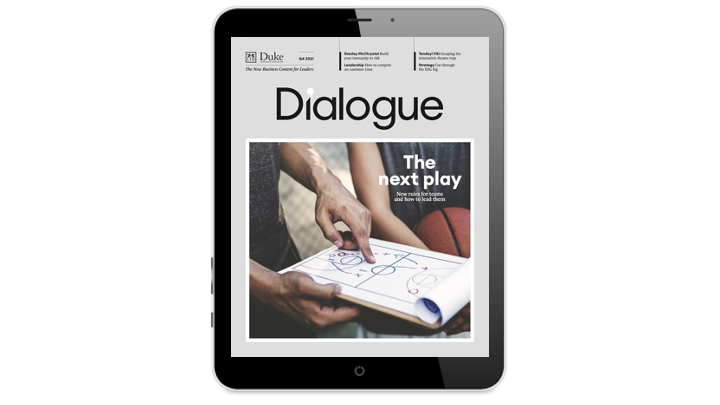Dialogue Q4, 2021 – AVAILABLE NOW!
In a crisis, teamwork comes to the fore. It’s been one of the stories of the pandemic: in organizations around the world, the sudden shock of disease and economic disruption prompted astonishing feats of teamwork. From frontline health services to businesses jolted into adapting products and taking services online, the pandemic – especially in its early days – created rare shared purpose and clarity of focus.
Yet, paradoxically, the pandemic has also pushed many teams apart. For those of us who thrive on working cheek-by-jowl with colleagues, it has been a long drought. Even for those for whom colleague interaction was more of an occasional treat, this has been a rare period of abstinence. Robbed of their usual ways of working, teams have had to revisit foundational basics: how do we do things? How do we stay in touch? How do we share critical information?
That process has had real benefits. Amid the natural, bullish impatience to declare the pandemic ‘done’ and get back to ‘normality’ (something that’s only realistic in some parts of the world, of course, as the pandemic continues to rage), it’s essential that we recognize and retain those gains for our teams. That’s all the more important because of the underlying shifts in how we work, which predated – and will outlive – the pandemic: the drivers of intense competition, digitization, and the dynamics making the business world more volatile, uncertain, complex and ambiguous.
Those changes have made teams the “atomic” unit of work today, as Sanyin Siang and Michael Canning put it in their feature. The performance of teams is critical to organizational success; but for them to thrive, leaders need to fulfil a new role as team coach.
Unfortunately, the reality is that many teams are mediocre, as Martha Maznevski writes: they muddle their way through. The pandemic, however, has shown us in vivid colour just how teams can evolve to deliver super results. And with virtual working sure to stay, don’t miss Erica Dhawan’s essential tips for how our ‘digital body language’ can catch up with our new ways of working.
Elsewhere in the issue, we have a special feature from B Joseph Pine II and James H Gilmore on that uniquely precious resource: time. Too many businesses are careless with their customers’ time, but there is competitive advantage to be found in helping customers to save time, in creating experiences to help them spend it well, or even in enabling customers to invest their time in transformational goals. The theme of transformation is picked up by Nick Jankel, who explains why leaders need a new mindset to lead change, time and again – but often remain trapped by an outdated legacy mindset.
We also turn our eyes to China. Edward Tse reveals the foundations of China’s breathtaking economic success, and sketches three scenarios for its geopolitical and economic future. We take a closer look at some of the key numbers with the News Nation profile, while finance columnist Phil Young argues that the road to Covid recovery runs through Shanghai.
For the duration of the pandemic, and for the recovery, team performance will be critical. We’re stronger together.

